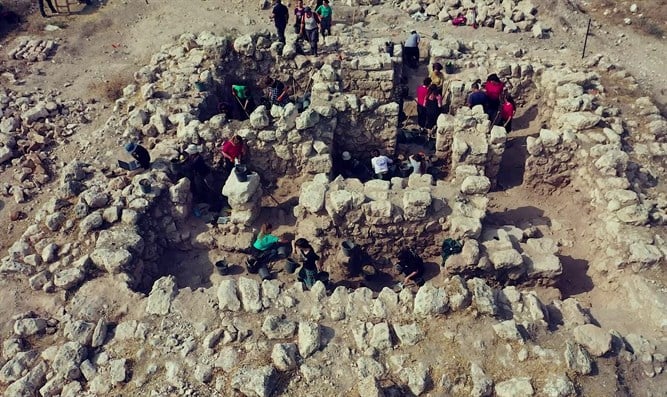Its destruction testifies to the battles the Maccabean dynasty kept fighting even after regaining Judea’s independence in the second century BCE.
By Batya Jerenberg, World Israel News
A Hasmonean-era fortress recently discovered in the Lachish region of Israel attests to the battles that the ancient Maccabees kept fighting even after regaining Judea’s independence from the Seleucid Empire in the famed Chanukah story.
The 2,100-year-old structure, a 15x15m. building, was found on top of a high hill overlooking a major road of ancient times that connected the coastal plain to the mountains. It had three-meter-thick outer walls of very large stones that were built on an angle to discourage enemy troops from scaling it.
There were seven rooms inside, and the remains of a staircase proved that it had another floor as well. Archeologists from the Israel Antiquities Authority (IAA) estimate that it had stood some five meters high.
“It appears that we have discovered a building that was part of a fortified line erected by the Hellenistic army commanders to protect the large Hellenistic city of Maresha from a Hasmonean offensive,” said IAA excavation directors Saar Ganor, Vladik Lifshits and Ahinoam Montagu. “However, the finds from the site show that the Seleucid defenses were unsuccessful; the excavated building was badly burnt and devastated by the Hasmoneans.”
After removing thousands of stones that had collapsed from the higher floor, a destruction layer half a meter thick was uncovered that contained many coins, iron weapons, slingshot stones, burnt wooden beams and pottery shards.
“Based on the finds and coins, the building’s destruction can be attributed to the Hasmonean leader John Hyrcanus’s conquest of the region of Idumea around 112 BCE,” the archaeologists said.
That date would be well into the Hasmonean dynasty, the rulership of the family that led the revolt against the Seleucid Empire fifty years earlier that gave birth to the holiday of Chanukah. John Hyrcanus was the son of Simon Maccabee, who fought with his four brothers and father, Mattathias, against the Greeks who sought to impose their Hellenistic philosophy on the Jews of Judea.
The priestly family that had served in the Temple could not abide the rulers’ anti-religious decrees and desecration of their holy sanctuary and gathered a small force of like-minded Jews to fight for their freedom. It took some three years before Jerusalem was reconquered and the Temple rededicated, an event that has been celebrated ever since in the eight-day holiday in which candles are lit each night in a candlestick reminiscent of the Temple menorah.
The two volumes of the Book of the Maccabees, which were not included in the Biblical canon, describe battles that the famous dynasty fought in order to expand their kingdom following their success in driving out the Seleucids from Judea.
“The stories of the Maccabees are coming to life before our eyes” in this excavation, said the archeologists.
Funded by the Jerusalem and Heritage Ministry, the IAA has been working with the Jewish National Fund and two groups of students to excavate the site – high-schoolers majoring in both Land of Israel Studies and Archeology, and pre-military students from the Asher Ruach Bo program for at-risk youth.
Once the excavation is complete, it will join a string of sites that the public will be able to enjoy on what is being developed as the Kings of Judah Road.




